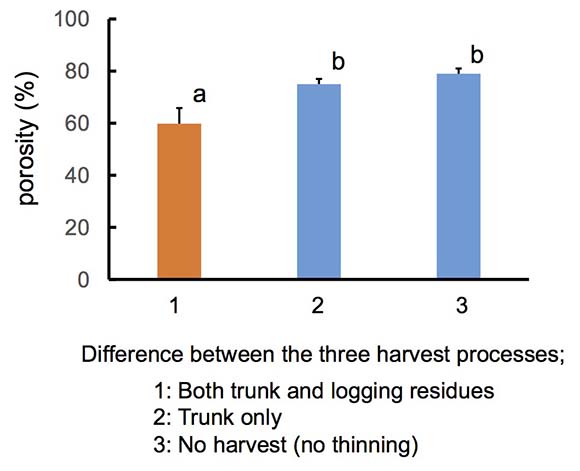Home > Research > Research Results > Research Results 2017 > Harvest of logging residues on steep slope decreases the water-retention capacity of forest soil
Update:July 21, 2017
Main content starts here.
Harvest of logging residues on steep slope decreases the water-retention capacity of forest soil
| Article title |
Impact of the harvest of logging residues at the thinning on the soil chemical and physical properties, and the stand growth of Japanese cedar (Cryptomeria japonica) |
|---|---|
| Author (affiliation) |
Tsuyoshi Yamada (a), Yukio Takahashi (b), Tomohiro Nishizono (c), Eiji Kodani (d), Tomomasa Amano (d), Keizo Hirai (a) |
| Publication Journal |
Japanese Journal of Forest Environment, 58(2): 61-68, December 2016, |
| Content introduction |
Woody biomass is gaining attention as a renewable energy source. With the construction of woody biomass power plants in various regions of Japan, we are witnessing progress in the utilization of unused wood after thinning as biomass fuel as well as in the use of logging residues. Logging residues not only provide nutrients but also play the role of protecting the soil surface and preventing soil erosion. Therefore, to clarify the impact that the harvest of logging residues on steep slopes has on soil properties, we compared soil porosity (ratio of the spaces in which water and air can be stored in the soil) in three processes: harvesting both trunks and logging residues, harvesting only trunks, and harvesting neither trunks nor logging residues (i.e., without thinning). The survey was performed three years after the thinning in a 45-year-old cedar forest (32°–43° incline) in Kamaishi, Iwate Prefecture. When harvesting both trunks and logging residues, the porosity of the surface soil decreased by 15% when compared with the other two cases (figure). This is because in this process, the cover protecting the ground surface is removed and rain drops come into direct contact with the soil, thus destroying soil structure and blocking the infiltration to the pores. It is considered that this prevents infiltration of rain water within the soil and thereby leads to a decrease in the water-retention capacity of soil. This result demonstrates that harvest of logging residues on steep slopes should be avoided both in the cases of clear-cutting and thinning. It is also considered that reducing the harvested amount of logging residues on gentle slopes and increasing the amount of vegetation on the forest floor can effectively protect the soil surface and maintain its porosity. In the future, it is necessary to ascertain the harvest ratio of logging residues (what percentage of logging residues can be harvested?) according to the various environmental conditions of the soil.
Figure. Impact of harvesting trunks and logging residues after thinning on the porosity of the surface soil. The error bar indicates the standard deviation. The treatment indicated with different symbols shows a significant difference in the mean porosity value (p < 0.05). |
Copyright © Forest Research and Management Organization. All rights reserved.

